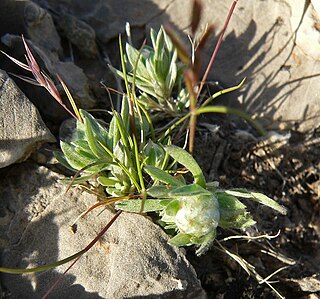
Stylocline(neststraw) is a small genus of North American desert plants in the tribe Gnaphalieae within the family Asteraceae.

Constancea is a monotypic genus of flowering plants in the family Asteraceae containing the single species Constancea nevinii, which is known by the common name Nevin's woolly sunflower. It is endemic to three of the Channel Islands of California, where it grows in coastal scrub habitat. This is a small shrub or subshrub generally growing up to one or 1.5 meters tall, and taller when an erect form, with a branching, woolly stem. The whitish, woolly oval leaves may be up to 20 centimeters long and are divided into many narrow lobes with edges curled under. The inflorescence is a cluster of 10 to 50 or more small flower heads, each on a short peduncle. The flower head has a center of hairy, glandular, star-shaped yellow disc florets and a fringe of four to nine yellow ray florets, each about 2 millimeters long. The fruit is an achene a few millimeters long with a small pappus at the tip.
Micropus amphibolus is a species of flowering plant in the family Asteraceae known by the common name Mount Diablo cottonseed. It is endemic to California, where it is known from the San Francisco Bay Area and nearby mountains, growing in open, rocky habitat. It is an annual herb similar in appearance to its relative, Micropus californicus, called the "Q-tips". It produces one or more small, erect stems coated thinly in wispy, webby fibers. The inflorescence is a spherical flower head a few millimeters wide which resembles a tiny cotton boll since the flowers and maturing fruits are very woolly.

Monolopia gracilens is a species of flowering plant in the family Asteraceae known by the common name woodland monolopia. It is endemic to California, where it is known from the mountains of the San Francisco Bay Area and ranges just to the south. It grows in grassland, chaparral, woodland, and other habitat, often on serpentine soils. It is an annual herb producing a slender, branching stem up to about 80 centimeters tall. It is usually somewhat woolly in texture. The inflorescences at the ends of stem branches bear small hemispheric flower heads. The golden ray florets are up to a centimeter long and surround a center of many disc florets. The fruit is an achene about 2 millimeters long.
Pseudobahia bahiifolia is a rare species of flowering plant in the family Asteraceae known by the common name Hartweg's golden sunburst.

Psilocarphus brevissimus is a species of flowering plant in the family Asteraceae known by the common names short woollyheads, woolly marbles, and woolly heads.
Psilocarphus oregonus is a species of flowering plant in the family Asteraceae known by the common names Oregon woollyheads and Oregon woolly marbles. It is native to western North America from Washington and Idaho to Baja California, where it grows in seasonally wet habitat, such as vernal pools.

Psilocarphus tenellus is a species of flowering plant in the family Asteraceae known by the common names slender woollyheads and slender woolly marbles. It is native to western North America from far southwestern British Columbia to Baja California, where it grows in seasonally wet habitat, such as vernal pools, as well as coastline and disturbed areas.

Pyrrocoma apargioides is a species of flowering plant in the family Asteraceae known by the common name alpineflames. It is native to the western United States from the Sierra Nevada of California east to Utah, where it grows in the forests and meadows of high mountains. It is a perennial herb growing from a taproot and producing one or more stems to 30 centimeters in length. The stems are decumbent or upright, reddish, and hairless to slightly woolly. Most of the leaves are located around the base. They are thick and leathery, lance-shaped with large sawteeth along the edges, often center-striped in white, and measure up to 10 centimeters long. The inflorescence is usually a single flower head lined with centimeter-long phyllaries which are reddish to green with red edges. The head has a center of yellow disc florets and a fringe of ray florets which are yellow, often splashed with red along the undersides, measuring up to 1.6 centimeters in length. The fruit is an achene which may be well over a centimeter in length including its pappus.
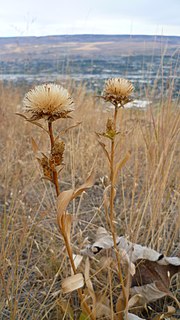
Pyrrocoma carthamoides is a species of flowering plant in the family Asteraceae known by the common name largeflower goldenweed. It is native to western North America from British Columbia to northeastern California to Wyoming, where it is known from grassland, woodlands, forests, barren areas, and other habitat. It is a perennial herb growing from a taproot and producing one or more stems to about half a meter in maximum length, the stems reddish-green and leafy. The largest leaves are at the base of the stem, measuring up to 20 centimeters long, lance-shaped with spiny sawtoothed edges. Leaves higher on the stem are smaller and hairier. The inflorescence is a single flower head or a cluster of up to four. Each bell-shaped head is lined with phyllaries each up to 2 centimeters long. It has many yellow disc florets surrounded by a fringe of yellow ray florets up to 7 millimeters long; ray florets are occasionally absent. The fruit is an achene which may be well over a centimeter in length including its pappus.
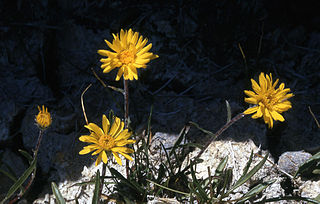
Pyrrocoma uniflora is a species of flowering plant in the family Asteraceae known by the common name plantain goldenweed. It is native to western North America from central Canada to California to Colorado, where it grows in several types of habitat, including forest and meadows with alkali soils, such as those near hot springs. It is a perennial herb growing up to 40 centimeters tall, the stems reddish and usually with a thin to thick coating of woolly fibers. The lance-shaped, toothed leaves are usually woolly, the largest near the base of the plant reaching up to 12 centimeters in length. The inflorescence is a single flower head or a cluster of a few heads, each lined with woolly phyllaries. The head contains yellow disc and ray florets. The fruit is an achene which may be over a centimeter long including its long pappus.
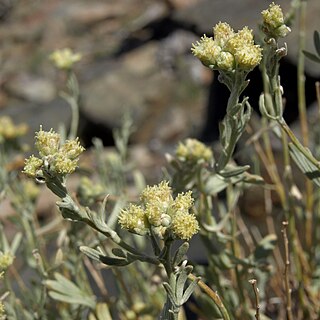
Sphaeromeria cana is a species of flowering plant in the family Asteraceae known by the common name gray chickensage. It is native to the western United States, where it is known from the Sierra Nevada, the adjacent desert ranges of eastern California and Nevada, and Steens Mountain of Oregon. It grows in dry, rocky mountain habitat, such as cracks and crevices, including the talus above the tree line. This is an aromatic subshrub with numerous erect branches growing up to 30 to 60 centimeters tall. It is gray-green in color and coated with woolly fibers. The leaves are linear or lance-shaped, the lower ones divided into lobes. The inflorescence is generally a cluster of flower heads lined with woolly phyllaries and containing yellow disc florets. There are no ray florets. The fruit is a ribbed achene about 2 millimeters long.
Stylocline citroleum is a rare species of flowering plant in the family Asteraceae known by the common name oil neststraw.
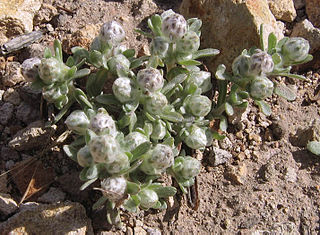
Stylocline gnaphaloides is a species of flowering plant in the aster family known by the common names mountain neststraw and everlasting neststraw.
Stylocline intertexta is a species of flowering plant in the family Asteraceae known by the common names Morefield's neststraw and Mojave neststraw. It is native to the Mojave and Sonoran Deserts of California, Nevada, Utah, and Arizona, where it grows in rocky, sandy desert soils. It likely evolved as a hybrid between woollyhead neststraw and baretwig neststraw ; it is a mix of their morphological traits and it occurs alongside both of them. It reproduces itself, producing fertile offspring, and it meets other criteria for any other definition of a species, so it was described to science as such in 1992. It is a small annual herb growing at ground level and reaching just a few centimeters in length. It is usually coated in white hairs, often woolly. The small, pointed leaves are oval to lance-shaped and measure up to 1.5 centimeters long. The inflorescence bears spherical flower heads each a few millimeters in diameter. The head has no phyllaries, just a ball of tiny woolly white flowers.

Stylocline micropoides is a species of flowering plant in the family Asteraceae known by the common names woollyhead neststraw, woollyhead fanbract and desert neststraw. It is native to the southwestern United States and northern areas in the northern states of Mexico, where it grows in desert habitat and other dry areas. It is a small annual herb growing at ground level with stems up to 20 centimeters in length. It is woolly or felt-like in texture with a coating of white hairs. The pointed leaves are up to 2 centimeters long and alternately arranged. The inflorescence bears spherical flower heads no more than a centimeter in diameter. The head generally has no phyllaries, or has small ones that fall away early. It contains several woolly white flowers.

Stylocline psilocarphoides is a species of flowering plant in the family Asteraceae known by the common names baretwig neststraw and Peck's neststraw. It is native to the western United States from Idaho to southeastern California, where it grows in deserts and other dry, sandy, gravelly habitat. It is a small annual herb growing at ground level with stems measuring 1 to 18 centimeters in length. It is woolly or felt-like in texture with a coating of white hairs. The pointed leaves are up to 1.8 centimeters long and alternately arranged. The inflorescence bears oval flower heads no more than half a centimeter in diameter. The head generally has no phyllaries, or has small ones that fall away early. It is a hardened ball of several woolly white flowers.
Tetradymia argyraea is a species of flowering plant in the aster family known by the common names striped cottonthorn and striped horsebrush. It is native to the desert mountains of the southwestern United States, particularly of California, Nevada, and Arizona, where it grows in desert woodland habitat. It is a woolly, spiny shrub growing one half to nearly two meters in maximum height. The erect stems are white-woolly except for bare stripes at intervals. The leaves are linear in shape and harden as they age, becoming spiny. The larger leaves are woolly and there are clusters of smaller, threadlike leaves which may be hairless. The inflorescence bears two to five flower heads which are each enveloped in five thick phyllaries coated in white woolly hairs. Each head contains five pale yellow flowers each around a centimeter long. Flowers are produced in summer, as late as September. The fruit is an achene a few millimeters long tipped with a pappus of bristles.

Townsendia condensata is a species of flowering plant in the family Asteraceae known by the common names cushion Townsend daisy and cushion townsendia. It is native to North America where it is known from many scattered occurrences in the mountains of the western United States and Alberta in Canada. It is mainly limited to the alpine climates of high mountain peaks, where it grows in meadows, tundra, and barren, rocky talus. It grows alongside other alpine plants such as Eriogonum androsaceum.

Ancistrocarphus filagineus is a North American species of flowering plants in the family Asteraceae, known by the common names woolly fishhooks and hooked groundstar. It is native to western North America, including Idaho, Oregon, Nevada, California, and Baja California.













